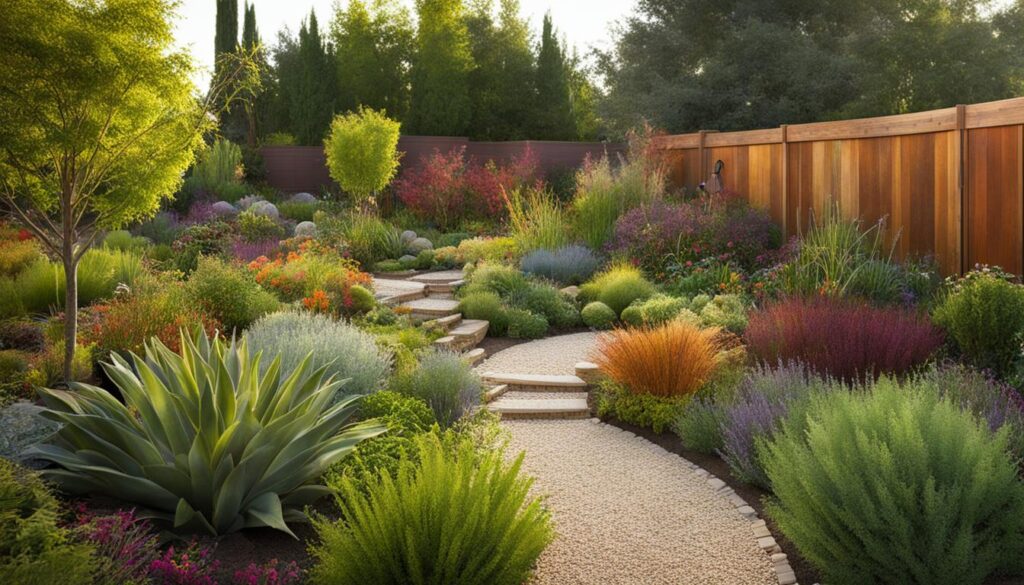Permaculture and xeriscaping are two approaches to landscape design that share a common goal: sustainability. Permaculture is a system of design based on observing and emulating natural patterns and processes to create resilient and productive systems. Xeriscaping, on the other hand, is a landscaping technique that aims to conserve water through the use of drought-resistant plants and water-saving techniques. When these two strategies are combined, they create a powerful synergy that results in highly efficient and sustainable landscape designs.
By integrating permaculture principles into xeriscaping practices, you can create landscapes that not only conserve water but also produce food, restore ecosystems, and support human well-being. The shared focus on sustainability, efficiency, and nature-inspired design principles makes permaculture and xeriscaping a perfect match.
Key Takeaways:
- Permaculture and xeriscaping share a common focus on sustainability and efficiency.
- Permaculture aims to create resilient and productive systems based on observing and emulating natural patterns and processes.
- Xeriscaping conserves water through the use of drought-resistant plants and water-saving techniques.
- The combination of permaculture and xeriscaping can result in highly efficient and sustainable landscape designs.
- Integrating permaculture principles into xeriscaping practices can create landscapes that conserve water, produce food, and support ecosystems.
The Benefits of Permaculture
Permaculture offers a wide range of benefits that make it a popular choice for those interested in sustainable agriculture and ecosystem restoration. By implementing permaculture principles, you can create resilient systems that not only produce an abundance of food but also improve soil health, enhance biodiversity, and reduce water consumption.
One of the key advantages of permaculture is its ability to increase food production in a sustainable manner. By observing and emulating nature’s patterns and processes, permaculturists create diverse and interconnected systems that maximize productivity while minimizing the use of synthetic inputs. This approach promotes the health of plants and animals, resulting in nutrient-rich crops and thriving ecosystems.
Furthermore, permaculture plays a crucial role in ecosystem restoration. Through practices such as regenerative agriculture, agroforestry, and water management techniques, permaculturists can reverse the damage done to degraded landscapes. By restoring soil health, reintroducing native plants, and creating habitat for wildlife, permaculture contributes to the revitalization of ecosystems and the preservation of biodiversity.
Sustainable Agriculture
Permaculture promotes sustainable agriculture by minimizing the use of chemical fertilizers and pesticides, relying instead on natural processes and symbiotic relationships. This reduces the environmental impact of food production and promotes healthier, more nutrient-dense crops.
“Permaculture allows us to grow our food in a way that is both environmentally responsible and economically viable.” – Permaculture enthusiast
Ecosystem Restoration
By restoring degraded ecosystems, permaculture helps to mitigate the effects of climate change, prevent soil erosion, and protect water resources. The use of regenerative practices such as cover cropping and rotational grazing helps to build soil organic matter and improve water infiltration, leading to healthier ecosystems and increased resilience.
- Improved food production
- Enhanced soil health
- Promotion of biodiversity
- Reduced water consumption
In conclusion, permaculture offers numerous benefits for sustainable agriculture and ecosystem restoration. By adopting permaculture principles, you can create productive and resilient systems that not only provide an abundance of food but also contribute to the preservation of our environment and the well-being of future generations.
Xeriscaping Principles for Water Conservation and Drought-Resistant Plants
Xeriscaping is a landscaping technique that focuses on water conservation and the use of drought-resistant plants. By implementing the following principles, you can create a beautiful and sustainable landscape that thrives even in water-limited environments.
1. Proper Planning and Design
Before starting your xeriscaping project, it’s essential to analyze your site’s conditions and plan accordingly. Consider factors such as sunlight exposure, soil type, and drainage patterns. Design your landscape to maximize water efficiency by grouping plants according to their water needs and creating microclimates that provide shade and reduce evaporation.
2. Efficient Irrigation Systems
Efficient irrigation plays a crucial role in xeriscaping. Install drip irrigation or low-flow sprinkler systems to deliver water directly to the plant’s roots, minimizing water loss to evaporation and runoff. Incorporate moisture sensors and timers to ensure that water is applied only when necessary and during optimal times.
3. Drought-Resistant Plants
Choose plants that are adapted to your local climate and have low water requirements. Native plants are often the best choice since they are naturally suited to the region’s conditions. Look for species that have evolved to withstand periods of drought and have features such as deep roots, succulent leaves, or silver-gray foliage that reduce water loss.
Implementing these principles in your xeriscaping project not only conserves water but also reduces maintenance needs and promotes a thriving, resilient landscape. With proper planning, efficient irrigation, and the right plant selection, you can create an aesthetically pleasing and environmentally friendly outdoor space that thrives even in arid climates.
– How can Permaculture Principles be Applied to Xeriscaping for Maximum Sustainability?
When implementing xeriscaping, it’s crucial to consider using the best plants for xeriscaping that are well-suited to the local climate and soil conditions. By applying permaculture principles, such as water conservation, diversity, and soil health, xeriscaping can achieve maximum sustainability while promoting natural ecosystems.
Synergy Strategies for Permaculture and Xeriscaping
The combination of permaculture and xeriscaping brings together two powerful approaches to sustainable landscape design. By integrating permaculture principles into xeriscaping projects, you can create landscapes that are not only visually appealing but also highly efficient and productive. These synergy strategies provide practical ways to harness the full potential of both permaculture and xeriscaping for a more sustainable and water-efficient garden.
1. Incorporate Edible Plants
One synergy strategy is to incorporate edible plants into your xeriscaped areas. By growing fruits, vegetables, and herbs alongside drought-resistant plants, you can maximize the productivity of your garden while conserving water. Choose edible plants that are well-suited to your climate and require minimal watering. Not only will this strategy enhance the functionality of your landscape, but it will also provide you with a source of fresh, homegrown produce.
2. Implement Water-Harvesting Techniques
Water is a precious resource, especially in water-limited environments. To make the most of every drop, consider implementing water-harvesting techniques in your permaculture-inspired xeriscaping project. This could include installing rainwater harvesting systems to capture and store rainwater for future use. You can also create swales, contour trenches, or other water-capturing features to slow down and retain rainwater in your garden. These techniques not only reduce your reliance on municipal water sources but also help nourish your plants during dry periods.
3. Apply Companion Planting
Companion planting is a synergistic gardening technique that involves growing compatible plant species together. By strategically pairing plants that support and complement each other, you can optimize resource utilization and minimize the risk of pests and diseases. When applying companion planting in your permaculture-inspired xeriscape, choose plants that have similar water and sunlight requirements. For example, plant shallow-rooted vegetables with deep-rooted, drought-resistant plants to maximize the use of soil moisture. Companion planting not only promotes a healthier garden ecosystem but also contributes to the overall resilience and productivity of your landscape.
Incorporating permaculture principles into xeriscaping projects offers a wealth of possibilities for sustainable landscape design. By synergizing the strengths of both approaches, you can create a garden that not only conserves water but also provides abundant beauty, biodiversity, and productivity. Whether you’re a homeowner or a professional landscaper, these synergy strategies can help you create a landscape that thrives in harmony with nature.
Conclusion
Permaculture and xeriscaping are two approaches to sustainable landscape design that offer a wealth of benefits. By integrating permaculture principles into xeriscaping practices, you can create landscapes that are not only visually pleasing but also productive and environmentally friendly. These synergistic strategies allow you to harness the power of nature-inspired gardening to transform your outdoor spaces into thriving ecosystems.
Through careful planning and implementation, you can create landscapes that support biodiversity, conserve water, and provide you with abundant food and beauty. By following permaculture principles such as regenerative agriculture, agroforestry, and water management techniques, you can enhance soil health, restore ecosystems, and minimize the use of synthetic inputs.
By combining permaculture and xeriscaping, you can create sustainable and resilient landscapes that require minimal inputs and maintenance. Incorporating edible plants into xeriscaped areas, utilizing water-harvesting techniques, and implementing companion planting are just a few of the strategies you can employ. Embracing the synergy between permaculture and xeriscaping allows you to create landscapes that not only benefit you but also contribute to a more sustainable and resilient future for our environments.












